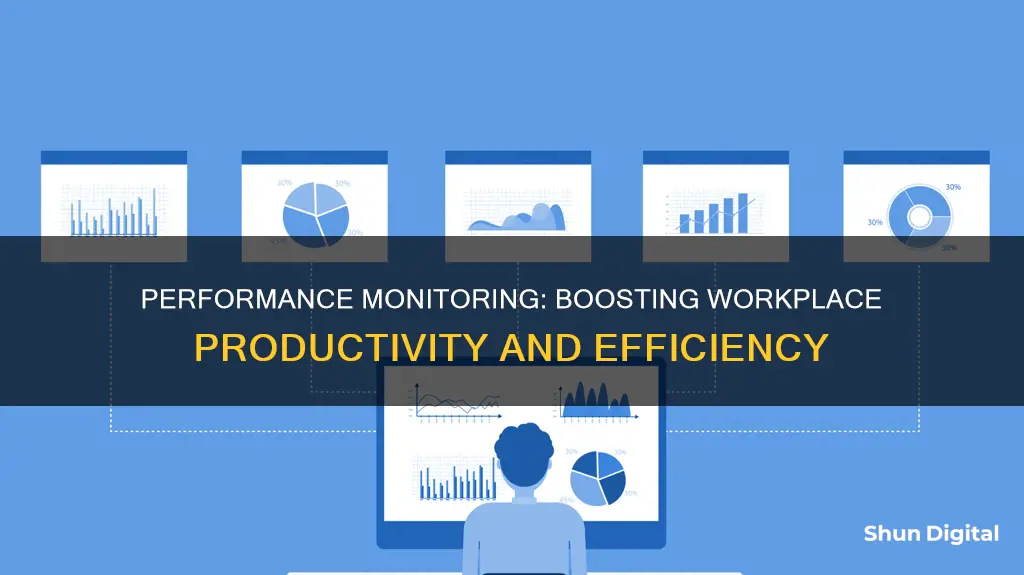
Performance monitoring is a strategic approach to ensure high workforce productivity and meet business goals. It involves tracking employees' work in terms of quality, quantity, and efficiency. It is a tricky process that requires a balance between business interests and employee privacy. However, it offers several benefits, including increased transparency, improved training programs, a culture of continuous learning, boosted productivity, and enhanced decision-making. Performance monitoring also helps identify training needs, promote fairness, adaptability, employee well-being, and recognition. It is a valuable tool for businesses of all sizes to improve productivity, efficiency, and overall performance.
What You'll Learn

Data-driven decision-making
Performance monitoring allows managers to analyse performance metrics, trends, and patterns, enabling them to make wise decisions regarding resource allocation, staffing levels, and strategic initiatives. For example, by tracking performance against sales targets, managers can identify high-performing employees and allocate resources accordingly. This data-driven approach ensures that decisions are based on facts rather than personal opinions, leading to better results.
Additionally, performance monitoring helps identify potential risks to the organisation. By monitoring performance indicators in real time, managers can identify areas of underperformance or compliance issues early on and take proactive measures to address them. This proactive approach minimises the risk of costly errors, legal liabilities, or damage to the organisation's reputation.
Performance monitoring also facilitates adaptability and flexibility. In today's dynamic business environment, organisations must be able to respond quickly to changing market conditions and customer demands. By monitoring employee performance, organisations can identify emerging trends and adjust their strategies and processes accordingly, ensuring they stay ahead of the competition.
Furthermore, performance monitoring contributes to employee well-being and job satisfaction. When conducted constructively, it provides regular feedback, coaching, and recognition, demonstrating the organisation's commitment to employee development and success. This, in turn, promotes a positive work environment, where employees feel valued, motivated, and engaged, further contributing to the organisation's success.
Overall, data-driven decision-making through performance monitoring is a powerful tool for organisations to optimise their operations, minimise risks, and enhance employee satisfaction and retention, ultimately driving business growth and success.
Understanding Trace Free Technology on ASUS Monitors
You may want to see also

Identifying training needs
Performance monitoring is a way of keeping an eye on how well things are working. It involves regularly observing and evaluating how individuals or teams perform their tasks within an organisation. It is a crucial part of today's fast-paced business environment, helping organisations to identify emerging trends and adapt their strategies and processes accordingly.
Performance monitoring helps identify training and development needs across the organisation. By analysing performance data, managers can pinpoint areas where employees may require additional training or skill development to perform their roles effectively. This proactive approach to training ensures that employees have the necessary knowledge and skills to excel in their positions, ultimately driving improved performance and productivity.
- Clarify learning objectives and outcomes: Organisations must clearly define their learning objectives and desired outcomes to focus on the appropriate employee performance behaviours. For example, an organisation may aim to improve customer satisfaction scores or reduce product return rates. As a result, they should concentrate on the training areas that pertain to these particular goals.
- Determine the necessary skills and knowledge: This involves a detailed breakdown of the tasks involved, as well as the talents and skills employees require to complete these tasks. Even the smallest businesses have specific skills and knowledge that their employees need to obtain through proper training. For instance, persuasion or communication skills are necessary to enhance sales performance, while IT troubleshooting abilities can improve the effectiveness of a technical service team.
- Identify performance pain points: To diagnose the root of the problem, organisations should conduct a training needs analysis to identify skills gaps that hinder overall productivity. eLearning assessments can be used to indicate what employees know versus their training needs, helping to identify current performance and skills gaps on an individual level.
- Prioritise performance issues: There are limited training resources and hours available, so organisations need to prioritise the gaps based on their goals. For example, if hitting sales targets is a priority, then performance behaviours related to sales tasks, product knowledge, and customer service should take precedence.
- Evaluate current training resources: Organisations may already have suitable training materials, but they need to be delivered to the right employees. This involves matching employees with specific skill gaps and performance gaps with relevant training activities. Evaluating current resources can also help identify areas for improvement and repurpose or revise training materials.
By implementing these steps, organisations can develop effective training strategies that address the specific needs of their employees, leading to improved performance and productivity.
Monitor Arm Buying Guide: Choosing the Right One
You may want to see also

Boosts transparency
Performance monitoring in the workplace can be a tricky process, requiring a balance between business interests and employee privacy. However, when done effectively and with transparency, it can have numerous benefits, including boosting transparency.
Performance monitoring helps boost transparency by providing a clear picture of how employees are spending their working hours, especially with the rise of hybrid and remote work arrangements. With an effective monitoring strategy, employers can gain insights into:
- Start and end times of the workday
- Tasks worked on and time spent on each task
- Time spent on work-related applications and websites
This transparency enables employers to better understand staff performance and make more informed decisions.
Additionally, performance monitoring can help identify and address issues early on. By tracking employee performance, employers can pinpoint areas where employees may need additional support or improvements can be made. This proactive approach promotes transparency and ensures that issues are addressed before they escalate into larger problems.
Performance monitoring also fosters transparency between employees and management. By regularly reviewing and discussing performance, employees have a clearer understanding of expectations and goals, leading to improved trust and morale.
Furthermore, performance monitoring can help ensure compliance with company policies and safety regulations. By monitoring employee activities, employers can identify and address any safety hazards or policy violations, reducing the risk of accidents and legal issues.
Overall, performance monitoring in the workplace enhances transparency by providing valuable insights into employee activities, enabling better decision-making, addressing issues proactively, fostering trust and morale, and ensuring compliance with policies and safety regulations. These benefits contribute to a more efficient and productive work environment.
Finding Replacement Monitor Panels: A Step-by-Step Guide
You may want to see also

Increases employee retention
Performance monitoring is a strategic approach to ensure high workforce productivity and meet business goals. It is a tricky process that requires a balance between business interests and employee privacy. However, when done right, it can have several benefits, one of which is increased employee retention.
Constructive Feedback:
Performance monitoring allows employers to give constructive feedback to their employees. Regular feedback helps employees identify their strengths and areas of improvement. This, in turn, can motivate employees to enhance their skills and knowledge, leading to improved performance and job satisfaction.
Training and Development:
By monitoring employee performance, employers can identify skill gaps and provide targeted training and development programs. This ensures that employees receive relevant and effective training aligned with the company's goals. As per a LinkedIn report, 94% of employees say they would stay longer at a company that invests in their professional growth. Thus, performance monitoring can be a powerful tool to retain employees by addressing their developmental needs.
Recognition and Rewards:
Performance monitoring helps identify high-performing employees, allowing organizations to recognize and reward them accordingly. This not only motivates the recognized individuals but also sets a positive example for others, fostering a culture of excellence. When employees feel valued and appreciated, they are more likely to stay with the organization.
Transparency and Trust:
Performance monitoring promotes transparency and trust within the organization. By establishing clear performance standards and metrics, organizations minimize biases and favoritism. Employees feel confident that their contributions will be fairly evaluated and rewarded based on merit. This sense of fairness and transparency can lead to higher employee satisfaction and retention.
Performance-based Pay Structure:
Performance monitoring enables organizations to implement a performance-based pay structure, where compensation is linked to individual achievements. This provides employees with a clear understanding of how their performance impacts their earnings, motivating them to improve and remain with the company.
Employee Engagement:
Performance monitoring is a tool to engage employees by setting clear goals and expectations. It helps employees understand how their work contributes to the organization's success, increasing their commitment and engagement. Engaged employees are more likely to be satisfied with their jobs and less likely to leave the organization.
In conclusion, performance monitoring, when coupled with other engagement tools and transparent communication, can be a powerful strategy to increase employee retention. By providing feedback, recognizing achievements, and addressing developmental needs, organizations can create a positive and motivating work environment that encourages employees to stay and grow within the company.
CO2 Monitor Buying Guide: Where to Purchase
You may want to see also

Improves accountability
Performance monitoring in the workplace improves accountability by ensuring employees are aware that their work is being tracked, which helps them stay focused and motivated to meet their goals. This tracking can also help identify areas where employees may need additional training or support, improving their overall performance and ensuring they are held accountable for their work outputs.
Performance monitoring also helps organisations identify employees who are suitable for promotion, as all employees will go through the same performance review process, allowing for a transparent and fair evaluation. This process can also help identify employees who are not meeting expectations and may need to be disciplined or terminated.
Additionally, performance monitoring can help organisations ensure that their employees are adhering to company policies and performing to expectations. This can reduce the need for disciplinary action and maintain a safe and healthy workplace.
Furthermore, performance monitoring can provide valuable data and insights to inform strategic decision-making within the organisation. By analysing performance metrics, trends, and patterns, managers can make informed decisions regarding resource allocation, staffing levels, and strategic initiatives. This data-driven approach ensures that decisions are based on facts rather than personal opinions, leading to better results.
Finally, performance monitoring can help improve employee morale and job satisfaction. By providing regular feedback, coaching, and recognition, organisations show their commitment to employee development and success. This, in turn, promotes a positive work environment where employees feel valued, motivated, and engaged in their work, leading to improved accountability.
Monitoring WiFi Usage: Track, Analyze, and Optimize Your Network
You may want to see also
Frequently asked questions
Performance monitoring is a strategic approach to ensure high workforce productivity and meet business goals. It involves tracking employees' work in terms of quality, quantity, and efficiency.
Performance monitoring is important because it helps businesses ensure smooth operations, identify areas for improvement, and ultimately achieve their goals. It also provides valuable insights that can be used to optimise productivity and stay competitive.
Performance monitoring provides employees with clear expectations and goals, regular feedback on their performance, and recognition for their achievements. It also creates an opportunity for employees to receive coaching and additional training to improve their skills.
Performance monitoring helps organisations make data-driven decisions, identify training needs, improve resource allocation, and ensure compliance with legal and regulatory requirements. It also contributes to a culture of continuous learning and development, promoting fairness and transparency in the evaluation of employee performance.
Performance monitoring helps businesses keep track of how well their systems, applications, and employees are performing. It enables them to identify areas of improvement, optimise productivity, and stay competitive in the market. By monitoring employee performance, organisations can ensure that their efforts are aligned with their goals and customer needs.







